
Major General Robertus Carolus Nicolaa Remkes is Director, Strategy, Policy and Assessments, U.S. European Command, Stuttgart-Vaihingen, Germany. As Director of Strategy, Plans and Policy, he is responsible for formulation and staff direction of the execution of basic military and political policy, as well as planning for command activities involving relations with other U.S. Unified Commands, allied military and international military organizations and subordinate commands. He also serves as Director of Capabilities and Assessments. In this capacity he is responsible for the development of force structure requirements; conducting studies, analyses and assessments; and for evaluating military forces, plans, programs and strategies.

Joseph William Ashy, is a retired United States Air Force general who was commander in chief of North American Aerospace Defense Command and United States Space Command, and commander of Air Force Space Command, headquartered at Peterson Air Force Base, Colorado. As commander of NORAD, General Ashy was responsible for the air sovereignty of the United States and Canada, as well as for providing tactical warning and attack assessment. As USCINCSPACE, he commanded the unified command responsible for directing space control and support operations including theater missile defense. As COMAFSPC, he directed satellite control, warning, space launch and ballistic missile operations missions through a worldwide network of support facilities and bases.
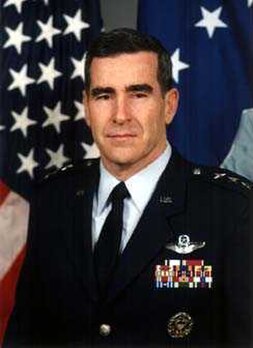
Lieutenant General David J. McCloud was an American Air Force lieutenant general.

Lieutenant General Buster Cleveland Glosson was the deputy chief of staff for plans and operations at the headquarters for the U.S. Air Force in Washington D.C. He was responsible to the secretary of the Air Force and chief of staff for the planning, operations, requirements and force structure necessary to support military operations. As the Air Force operations deputy to the Joint Chiefs of Staff, he determined operational requirements, concepts, doctrine, strategy, training and the assets necessary to support national security objectives and military strategy.

Robert E. Kelley was a United States Air Force lieutenant general, the ninth Superintendent of the U.S. Air Force Academy. He retired as a lieutenant general on September 1, 1986.
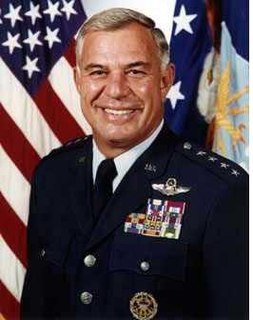
General John George Lorber served as commander of Pacific Air Forces, Hickam Air Force Base, Hawaii. As commander, he had responsibility for Air Force activities spread over half the world in a command that supports 44,000 Air Force people serving principally in Hawaii, Alaska, Guam, South Korea and Japan.

John K. McMullen is the Commander, 9th Air and Space Expeditionary Task Force - Afghanistan, Commander, NATO Air Command-Afghanistan, and the Deputy Commander-Air, U.S. Forces- Afghanistan. In these command roles, he oversees two NATO aerial ports of debarkation, two air expeditionary wings and two expeditionary groups consisting of more than 6,900 Airmen. He also advises and assists with joint expeditionary tasked/individual augmentee taskings in the Afghanistan combined joint operating area and ensures the optimal integration of air and space power in support of Headquarters ISAF and Operation Enduring Freedom missions. As the Commander, NATO Air Command-Afghanistan, he is responsible for developing the Afghan Air Force. In addition to these three command functions, Major General McMullen serves as the Central Command Combined Forces Air Component Commander's personal representative to the ISAF Commander as the Air Component Coordination Element liaison and also serves on the ISAF Joint Command staff as the Deputy Chief of Staff-Air.

Patrick K. Gamble is a retired president of the University of Alaska and a retired Air Force general whose assignments included service as Commander, Pacific Air Forces, Hickam Air Force Base, Hawaii.
Louis G Leiser was a major general in the United States Air Force.
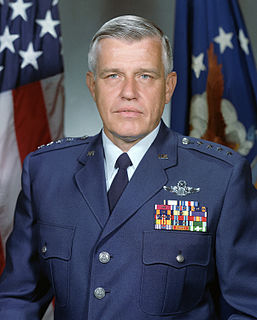
Robert Dale Russ was a United States Air Force general and commander of the Tactical Air Command.
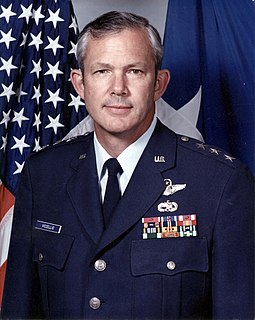
Henry Viccellio Jr. is a former General in the United States Air Force and the former commander of the Air Force Materiel Command.
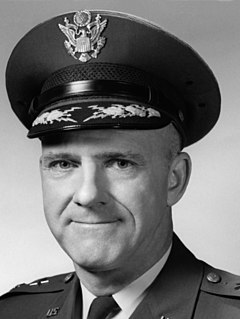
Lieutenant General Winton Whittier Marshall was a United States Air Force general and flying ace. He was deputy commander in chief, U.S. Readiness Command, with headquarters at MacDill Air Force Base, Florida before retiring in 1977.
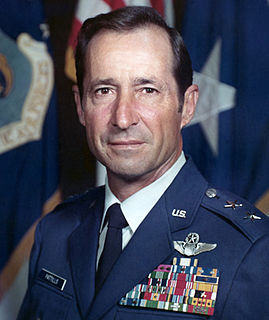
Charles Curtis Pattillo, also known as Buck Pattillo, was an American Air Force lieutenant general who was deputy commander in chief, U.S. Readiness Command and vice director of the Joint Deployment Agency with headquarters at MacDill Air Force Base, Florida. He died in May 2019 at the age of 94.

Lynwood Edgerton Clark was an American Air Force lieutenant general who was commander of the Alaskan Air Command, with additional duty as commander of Alaskan North American Aerospace Defense Region, Elmendorf Air Force Base, Alaska. The mission of the Alaskan Air Command is to provide top cover for America and air support in the defense of Alaska.
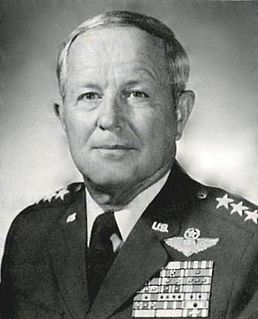
Freddie Lee Poston was an American lieutenant general who was chief of staff, United States Pacific Command, Camp H. M. Smith, Hawaii. Poston is responsible to the commander in chief Pacific for management of key military staff activities requiring coordinated Air Force, Navy, Army and Marine Corps operations throughout the Pacific Command. The Pacific Command is the United States' largest unified command, encompassing some 100 million square miles from the West Coast of the Americas to the east coast of Africa and from the arctic to the Antarctic.
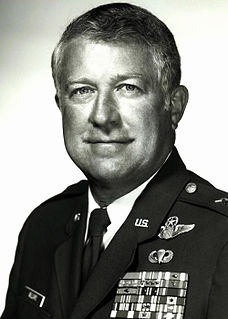
Gordon E. Williams is a retired United States Air Force officer. A command pilot with more than 4,000 flying hours, he flew numerous Air Force and Navy aircraft. Upon his retirement on 1 August 1988, he was the director for plans and policy, J-5, Headquarters United States European Command, Stuttgart-Vaihingen, West Germany.
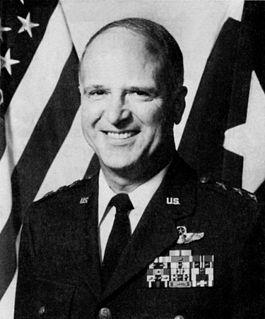
James Robert Brown was a lieutenant general in the United States Air Force who served as vice commander of Tactical Air Command, with headquarters at Langley Air Force Base, Virginia. The command comprises more than 118,000 military and civilian personnel, stationed at 18 major Tactical Air Command installations and other units in the United States, Panama, Okinawa and Iceland. Tactical Air Command was the operational combat organization for 74,000 Air National Guard and Air Force Reserve personnel throughout the United States.

Craven C. Rogers Jr. was a lieutenant general in the United States Air Force who served as deputy commander in chief of the U.S. Central Command at MacDill Air Force Base, Florida. The command was tasked with achieving United States national objectives in Southwest Asia, the Persian Gulf, and the Horn of Africa. Rogers was born in 1934, in Galveston, Texas. He earned a bachelor of science degree in engineering from the U.S. Military Academy in 1957 and a master's degree in business administration from The George Washington University. He completed Squadron Officer School in 1962 and the Industrial College of the Armed Forces in 1973. Upon graduation from the academy he was commissioned as a second lieutenant in the Air Force. After completing pilot training in September 1958 he was assigned to Tactical Air Command at Williams Air Force Base, Ariz., for gunnery training in the F-86F. With the phaseout of the F-86F, Rogers transferred in June 1959 as an instructor pilot to Air Training Command, Vance Air Force Base, Oklahoma. He completed F-101A transition training in September 1964 and then was assigned as a tactical fighter pilot with the 91st Tactical Fighter Squadron, Royal Air Force Station Bentwaters, England. In 1965 his squadron became the first unit in the United States Air Forces in Europe to transition to the F-4. Rogers assumed duties in the Standardization and Evaluation Section of the 81st Tactical Fighter Wing at Bentwaters in November 1966. In September 1967 he transferred to Nellis Air Force Base, Nevada, where he completed the F-4 Fighter Weapons School. In January 1968 he was assigned to the 557th Tactical Fighter Squadron, 12th Tactical Fighter Wing, Cam Ranh Bay Air Base, South Vietnam, as a flight commander and squadron weapons officer. He subsequently served as the wing weapons officer and assistant chief of weapons and tactics for 12th Tactical Fighter Wing. He flew 255 combat missions and 435 combat flying hours in the F-4C. He returned from Southeast Asia in February 1969 and was assigned to the Fighter and Reconnaissance Manning Section, Air Force Military Personnel Center, Randolph Air Force Base, Texas. He became chief of the section in 1971. Upon graduation from the Industrial College of the Armed Forces in August 1973, Rogers became deputy commander for operations, 1st Tactical Fighter Wing, MacDill Air Force Base, Florida. In June 1975 he transferred to Headquarters United States Air Force, Washington, D.C., as chief, Tactical Division, Directorate of Operational Requirements, Office of the Deputy Chief of Staff, Research and Development. In July 1977 Rogers was assigned as vice commander of the 4th Tactical Fighter Wing, Seymour Johnson Air Force Base, North Carolina. In June 1978 he became commander of the wing. He returned to Air Force headquarters in July 1980 and served as military assistant to the secretary of the Air Force. From June 1983 to July 1985 he was commander of United States Air Forces Korea; commander, United Nations Command Air Component; and commander, 314th Air Division, with headquarters at Osan Air Base, South Korea. He also was commander of the Korean Air Defense Sector, director of readiness and combat operations, and chief of staff of the Air Component Command/Combined Forces Command. Rogers then transferred to Hickam Air Force Base, Hawaii, as vice commander in chief, Pacific Air Forces. In December 1986 Rogers returned to Osan Air Base as commander, 7th Air Force; deputy commanding general, U.S. Forces Korea (Seoul); and deputy commander in chief, United Nations Command (Seoul). He is a command pilot with 5,200 flying hours. His military awards and decorations include the Defense Distinguished Service Medal with oak leaf cluster, Distinguished Service Medal, Legion of Merit with two oak leaf clusters, Distinguished Flying Cross with oak leaf cluster, Bronze Star Medal, Meritorious Service Medal with oak leaf cluster, Air Medal with 13 oak leaf clusters, Air Force Commendation Medal, Korean Order of National Security Merit (Chunsu) and Korean Order of National Security Merit (Kuksun). He was promoted to lieutenant general January 1, 1987, with same date of rank. He retired on April 1, 1991 and died on August 4, 2016.
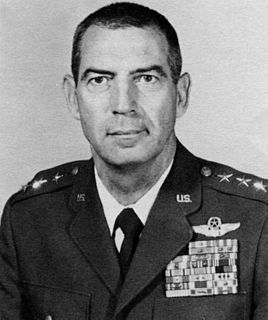
Walter Daniel Druen Jr. was a lieutenant general in the United States Air Force who served as commander of Allied Air Forces Southern Europe and deputy commander in chief, U.S. Air Forces in Europe (USAFE), Southern Area, with headquarters at Naples, Italy from July 1981 until his retirement in 1982.

Melbourne Kimsey is a retired brigadier general in the United States Air Force who served as director of the Cheyenne Mountain Complex from 1981 to 1983,



















